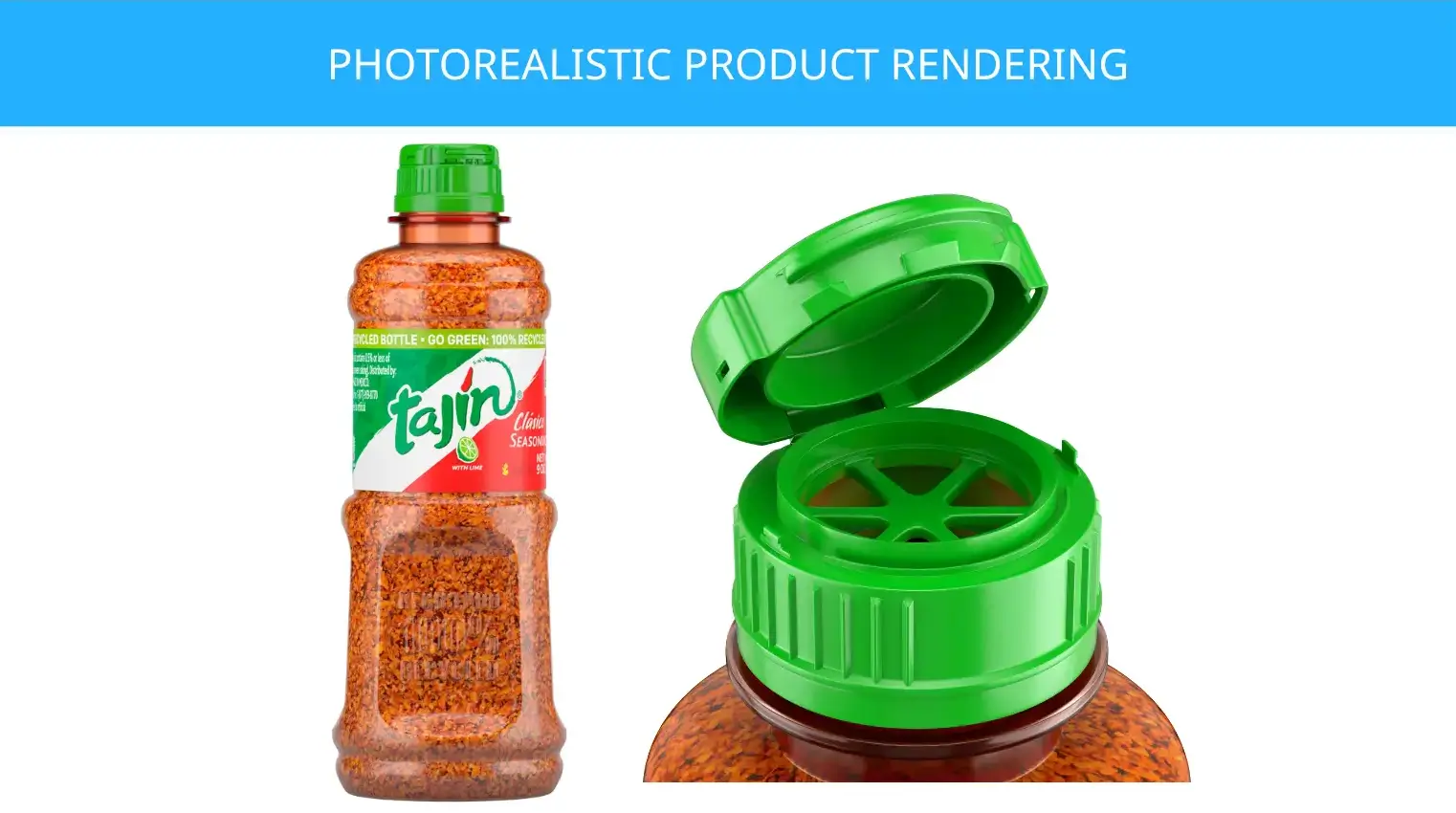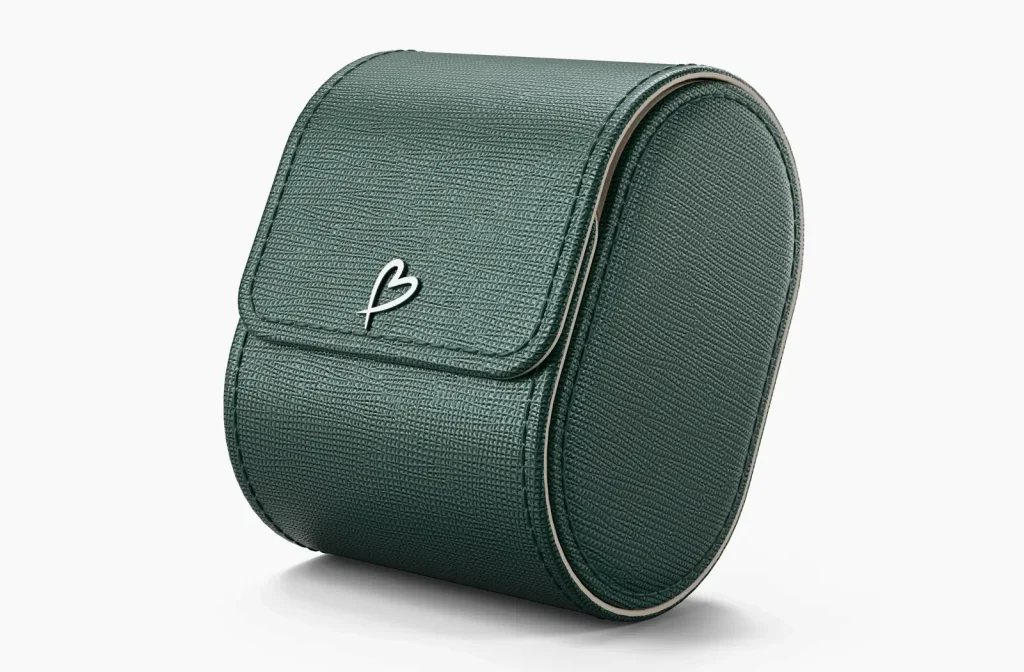
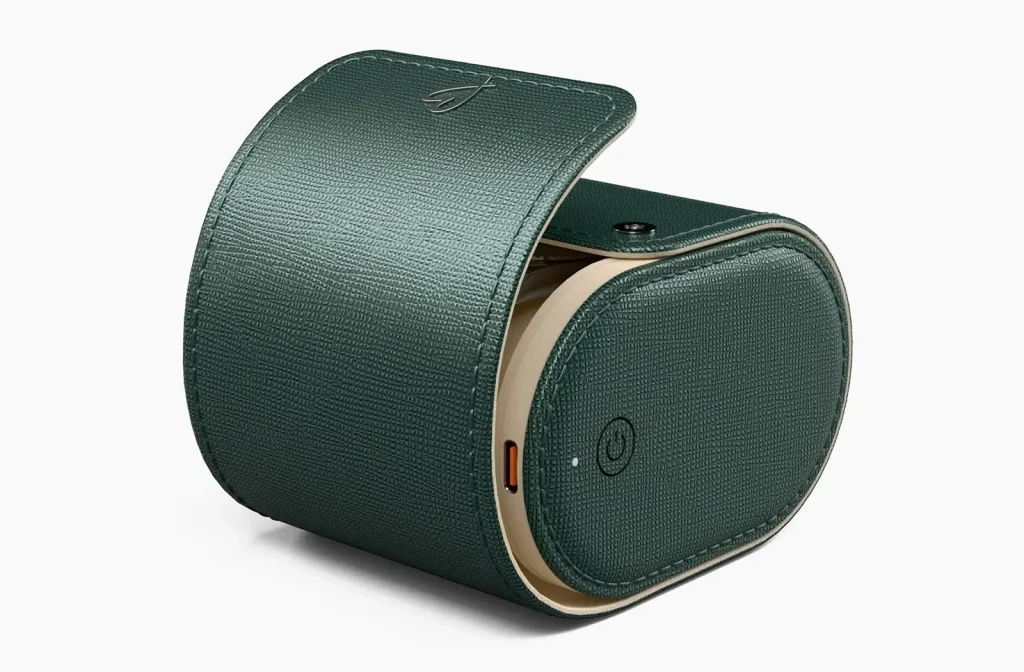

Photorealistic renders of a watch case
Businesses are increasingly turning to 3D product rendering for creating compelling marketing visuals. Utilizing 3D visualization in your content pipeline has several advantages over conventional visuals. The 3D models, once created, can be easily reused to create different variations of the product.
Within the broader realm of product rendering, the idea of photorealistic product rendering has gained immense significance. Photorealism is a highly sought-after characteristic in 3D outputs, valued for its ability to represent products with exceptional fidelity. This article delves into detail on photorealistic product rendering, its benefits and importance, enabling you to make well-informed decisions for your 3D visualization projects and harness this technology effectively.
Table Of Contents
- Key Insights At A Glance
- What Is Product Rendering
- What Is Photorealistic Product Rendering
- Key Elements In Achieving Photorealism
- Accurate 3D Modeling
- Realistic Materials And Textures
- Advanced Lighting Techniques
- Virtual Camera Simulation
- Post Processing
- How Photorealism Builds Trust
- Benefits Of Photorealistic Product Rendering
- Build Reliability and Trust
- Increased Engagement
- Evoking A Desire To Buy: More Conversions
- Better eCommerce Performance
- Improved Product Customization
- Challenges In Achieving Photorealism
- Overcoming The Challenges: How Is Photorealism Achieved At House Of Blue Beans
- Realism = Trust: The HoBB Guarantee
- FAQs
Key Insights At A Glance
- Photorealistic product rendering aims to create digital product visuals indistinguishable from actual photos, ensuring the highest accuracy in product representation.
- This commitment to truthful depiction is important for building customer trust, as it sets clear expectations and reduces perceived online purchase risks.
- Lifelike visuals significantly enhance e-commerce performance by increasing engagement, driving higher conversion rates, and reducing product returns.
- Achieving true photorealism depends on meticulous 3D modeling, expert material/texture application, advanced lighting, and precise camera simulation.
- Partnering with expert visualization service providers like House of Blue Beans, equipped with the right skills and resources, is key to obtaining impactful photorealistic renders.
What Is Product Rendering
Product rendering is the process of creating realistic 2D images or videos from a 3D digital model of a product. First, a three-dimensional model of the product is developed from CAD data or sculpted by 3D artists using reference images. On this model, materials and textures are applied digitally by professionals, and the lighting and camera angles are skillfully simulated to show how the product would appear in a chosen environment or studio setting. The software then calculates and generates the final visual output.
What Is Photorealistic Product Rendering
As the name implies, a product rendering is said to be photorealistic if the image obtained through rendering is indistinguishable from the real-life appearance of the physical product, capturing all its details. It is a process focused on achieving the utmost fidelity and realism in visual representation. Photorealism aims to represent the product as accurately and authentically as possible, bridging the gap between what is real and what is virtual.
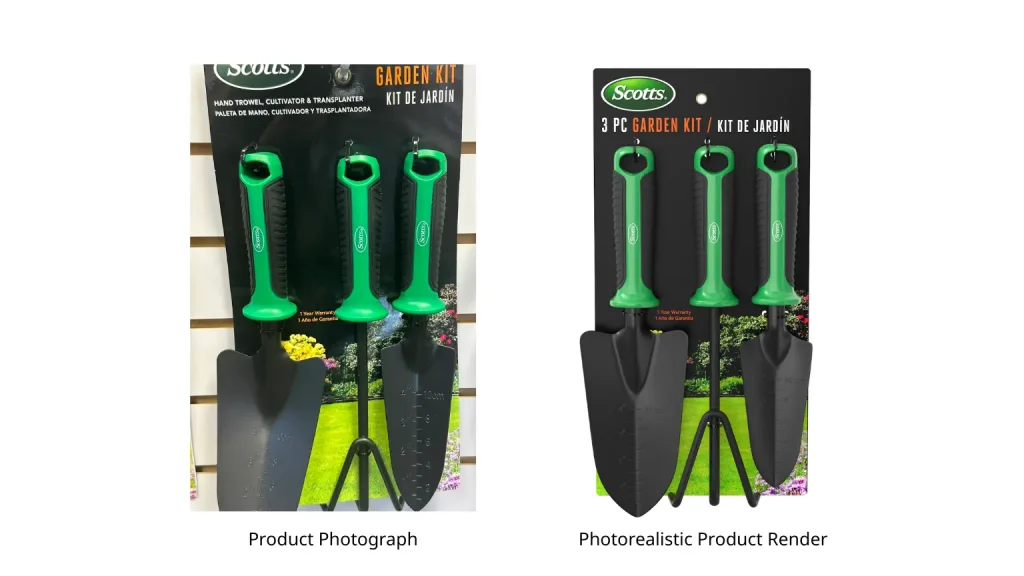
Achieving this level of realism involves great artistic skill and technical precision. This includes creating dimensionally accurate 3D models, applying materials and textures that precisely simulate how various surfaces interact with light, and implementing advanced lighting techniques to mimic natural or studio illumination with realistic shadows, reflections, and refractions. Minute details like capturing the real-world imperfection into the renders and accurate camera effects are crucial in attaining photorealism.
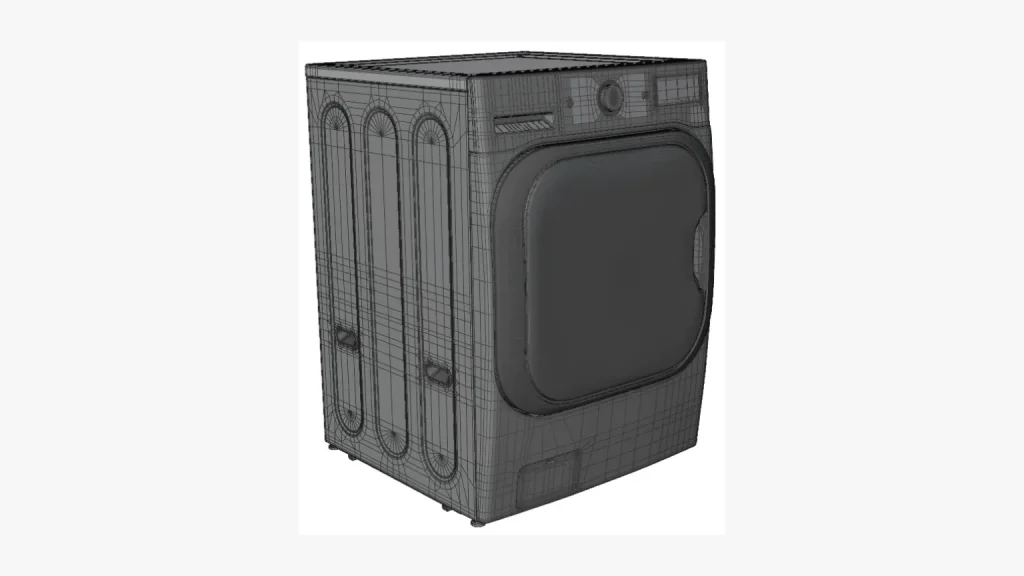
The Precise 3D Model used to create Photorealistic renders of a washing machine

Photorealistic rendering of a washing machine (i)
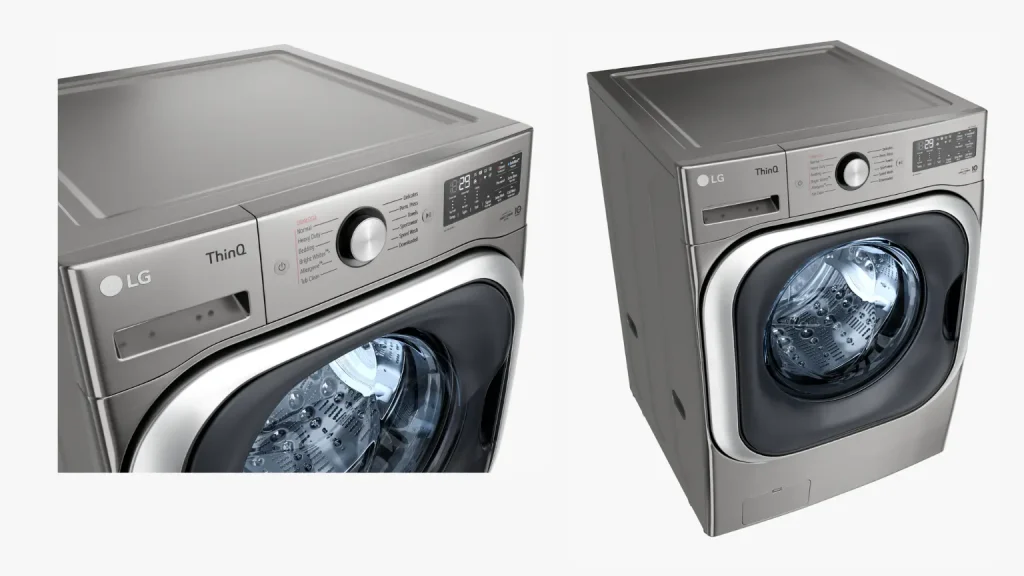
Photorealistic rendering of a washing machine (ii)
Key Elements In Achieving Photorealism
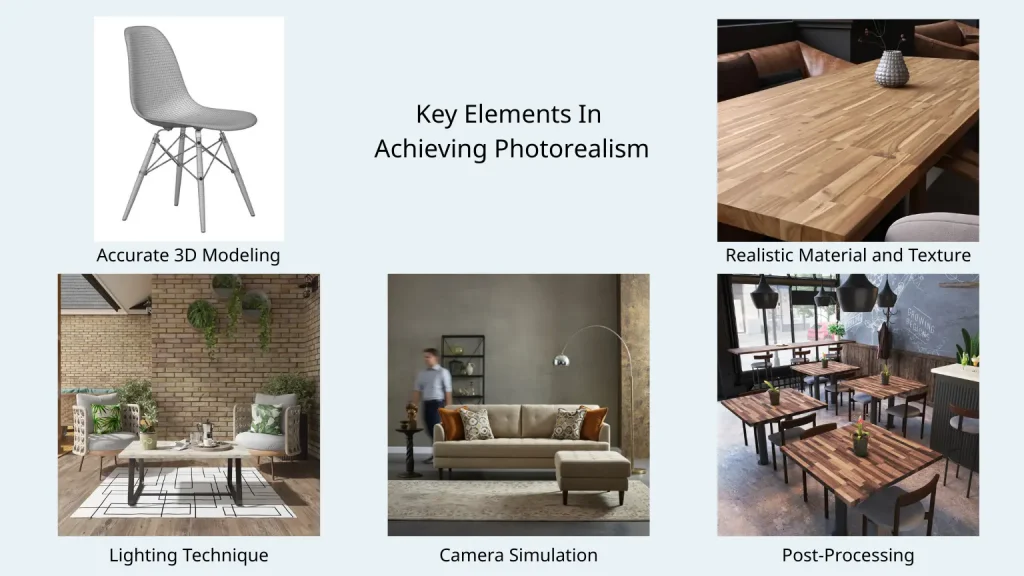
Achieving photorealism in 3D product rendering is a meticulous process that relies on several key elements working in harmony. The following are some of the most important ones.
Accurate 3D Modeling
- Precise Geometry & Scale: The 3D model is the base for everything that follows. So it must accurately represent the product’s true dimensions, proportions, and intricate details. Even slight inaccuracies can make the render feel artificial. At House of Blue Beans, geometrical accuracy down to fractions of a millimeter is attained. Tolerance level of ± 0.2 mm is attained on critical dimensions. This helps us accurately produce hole patterns, chamfers, stitch lines and faithful silhouettes.
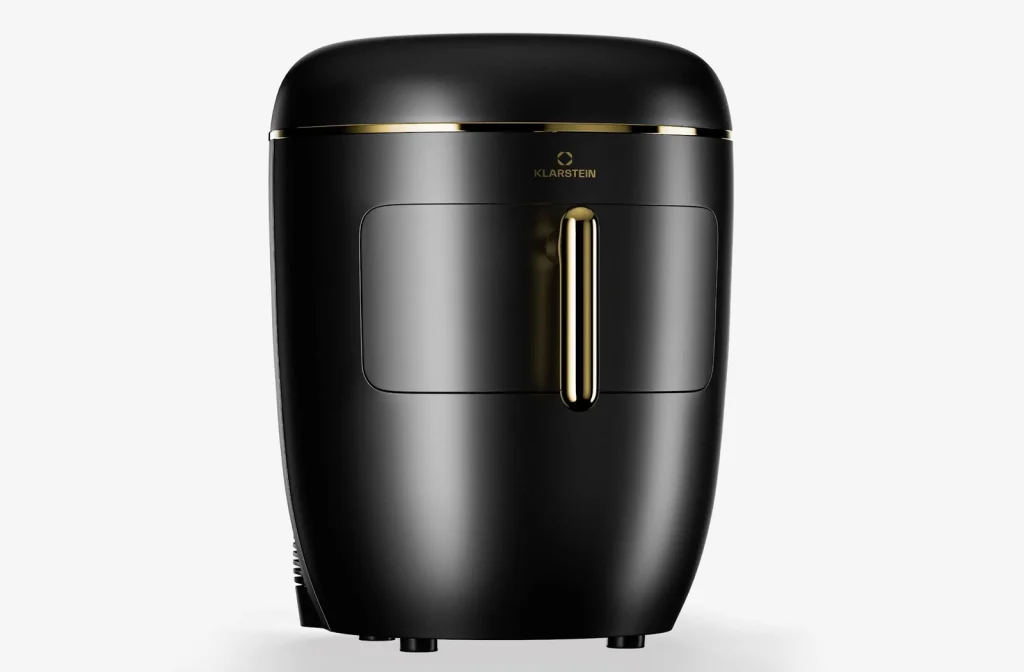
A Photorealistic Render of an Air Fryer
- Clean Topology: Well-constructed models with efficient polygon flow allow for better surface shading and texture application.
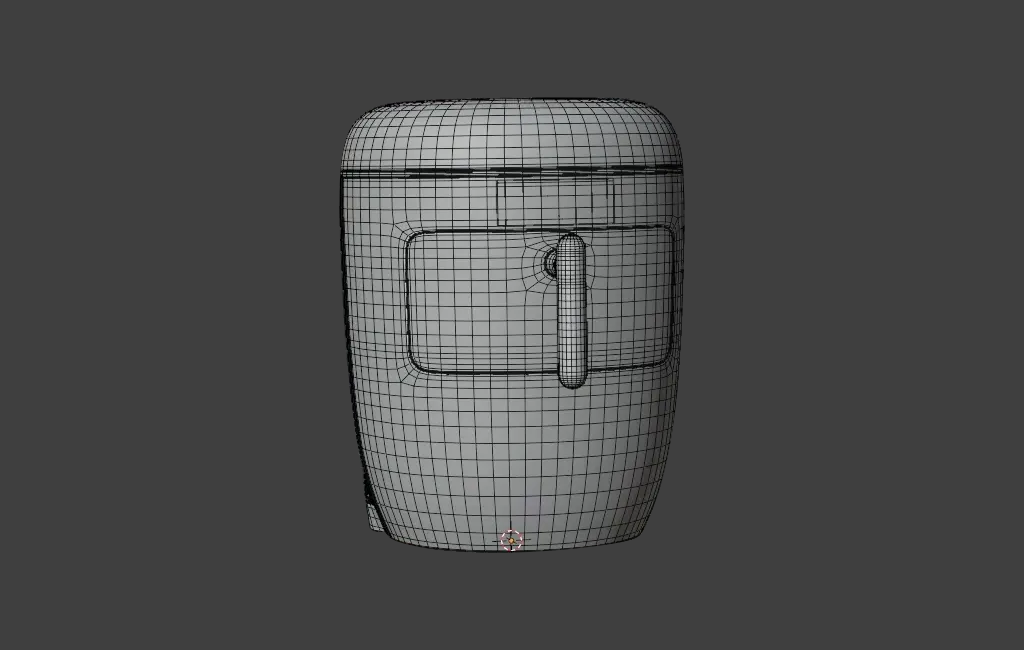
The 3D Model with a clean topology for efficient polygon flow
Realistic Materials and Textures (Shaders)
- Physically Based Rendering (PBR): This approach simulates how light interacts with real-world materials. Surface properties like roughness, metallicity, reflectivity, and translucency are defined. PBR utilizes a Bidirectional Reflectance Distribution Function (BRDF) that accurately models how light is reflected from a surface. This is based on the reflectance equation, which describes the relationship between incoming light, surface properties, and outgoing light.
- High-Resolution Textures: Detailed textures for color (albedo), bumps/normals (surface detail), roughness, and other properties are necessary for conveying the feel of materials like wood grain, fabric weave, brushed metal, or plastic finishes. You may also read more about texturing here: Defining Depths With Expert 3D Texturing Service
- Subtle Imperfections: Real-world objects have minor imperfections like dust, fingerprints, subtle scratches, or variations in texture. Adding these details (often through textures or procedural effects) significantly boosts realism.
Advanced Lighting Techniques
- Global Illumination (GI): Simulates how light bounces off surfaces and illuminates other objects indirectly, creating softer and more natural lighting.
- Accurate Light Sources: Mimicking real-world light sources, whether it’s natural sunlight (often using HDRI environment maps) or studio lighting setups (area lights, spotlights) with realistic intensity and falloff.
- Soft Shadows: Realistic shadows have soft edges (penumbras) and vary in intensity, which is essential for grounding objects in their environment.
- Reflections and Refractions: Accurately rendering how light reflects off shiny surfaces and refracts through transparent materials like glass or liquids.
Virtual Camera Simulation
- Depth of Field (DoF): Replicating the effect where parts of the image are in sharp focus while others are blurred, mimicking how a real camera lens works.
- Focal Length & Perspective: Choosing appropriate camera angles and focal lengths to showcase the product as accurately as possible.
Post-Processing
- Color Grading & Correction: Fine-tuning colors, contrast, brightness, and saturation to match a desired style or mood. Any surface details or color shade that needs to be refined are meticulously checked.
- Effects: Adding subtle effects like bloom, glare, or vignetting where appropriate to enhance visual quality.
How Photorealism Builds Trust

3D Rendering of a Garden Hose
In today’s marketplace, dominated by digital shopping experiences, photorealism lies at the heart of building trust among customers. In online shopping, buyers do not have the opportunity to physically inspect or touch the product. The listing images are just visual representations and often cannot match the experience of seeing a physical product. In such a scenario, photorealistic product rendering produces visuals that are indistinguishable from real-life products. By accurately depicting all the minute details of the product—its materials, textures, colors, form, and scale—these visuals set clear, honest expectations, significantly reducing the risk and uncertainty inherent in online shopping.
This commitment to truthful representation signals brand professionalism and transparency and makes customers feel more secure and confident in their purchasing decisions. It assures buyers that “what you see is what you’ll get,” cultivating lasting trust in the product and the brand.
Read more: How We Helped Forest Products Distributors Achieve Accurate Photorealistic Product Representations
Benefits Of Photorealistic Product Rendering
Build Reliability And Trust
As discussed previously in detail, this is the most important impact of photorealistic product rendering. Accurate and faithful representation of products will build confidence and trust in the company and its product offerings. This will lead to positive emotions in the customer, contributing to brand growth and loyalty.

Increased Engagement
Photorealistic product renderings significantly boost engagement on websites and e-commerce platforms. The lifelike visuals immediately capture the attention of the viewer and hold interest longer, encouraging visitors to explore products in greater detail. This leads to a captivating browsing experience for potential customers.
Read More: How High-Quality 3D Models Transformed Temple & Webster’s Product Visualization
Evoking A Desire To Buy: More Conversions

Photorealistic product renderings transform mere interest into an actual desire to buy. By showcasing items with accuracy and appealing detail, these visuals allow customers to vividly imagine owning and benefiting from the product. Product features and USPs are also better showcased with photorealism. The desirability, built upon the trust instilled by accurate representation, significantly increases purchase confidence, leading to higher conversions.
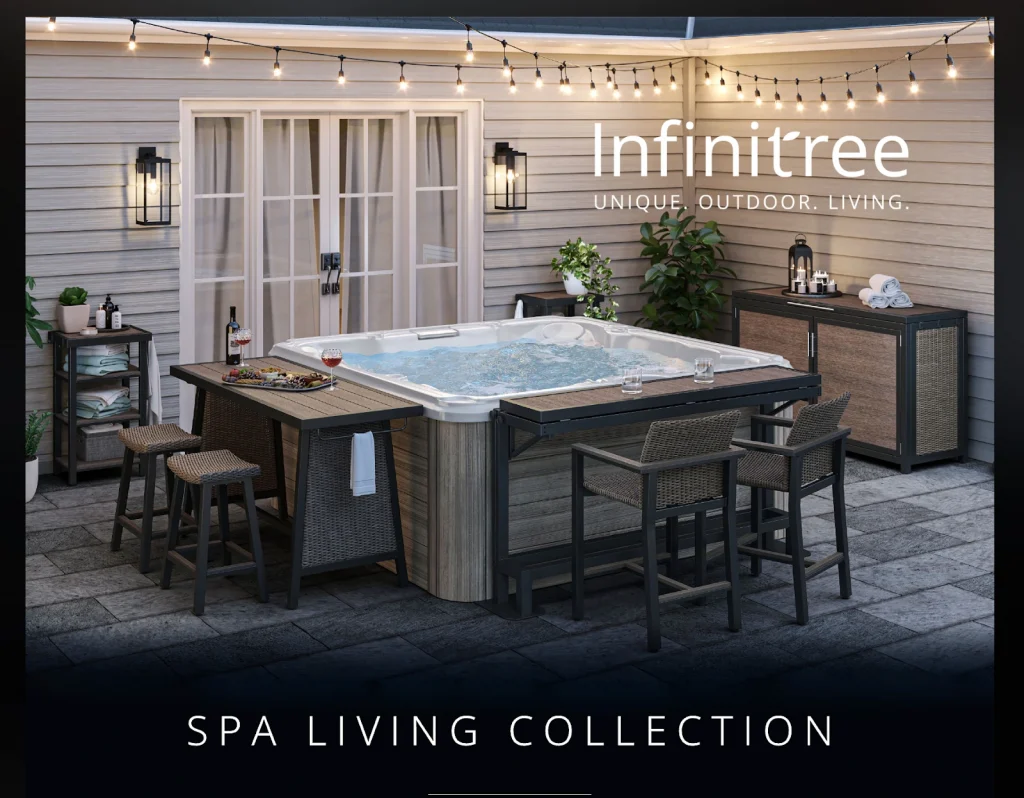
Read More: Transforming Wyze’s Product Sales Through Photorealistic CGI
Better eCommerce Performance
Photorealistic product renderings drive better e-commerce performance by setting clear customer expectations. The accuracy and visual appeal boost ‘Add to cart’ rates and decrease cart abandonment. Also, as products precisely match their online depiction, return rates are significantly reduced. This leads to greater customer satisfaction, translating into better product reviews and ratings.

Improved Product Customization
Photorealistic rendering aids in showcasing product customization. From a single 3D model, countless variations—different colors, materials, or features—can be accurately visualized. These products can be realistically placed in diverse lifestyle settings, allowing potential customers to connect more deeply with the products and imagine them in their own lives.
Read More: How Our Customized 3D Solutions Reinforced Lowe’s Home Appliance Sales
Challenges In Achieving Photorealism
As much as there are benefits, there are also several hurdles in the pursuit of photorealism. Some of them are listed below:
- Mastering Micro-Geometry & Topology: Creating highly detailed models with accurate micro-surface imperfections and clean, efficient topology for complex forms, while balancing high polygon counts with performance.
- Advanced Texturing & UV Unwrapping: Developing ultra-high-resolution, seamless textures and flawlessly UV mapping them onto intricate geometries without distortion or visible seams.
- Complex PBR Material Simulation: Accurately implementing PBR principles and simulating challenging optical phenomena like subsurface scattering (SSS), anisotropy and multi-layered materials, demanding precise data and intricate shader networks.
- Nuanced Lighting & Atmospheric Effects: Replicating sophisticated real-world lighting, including accurate global illumination, soft shadow gradations and precise HDRI control, often balancing realism with render time and noise.
- Realistic Camera Emulation & Subtle Post-Production: Accurately mimicking physical camera lens characteristics (depth of field, bokeh, subtle distortions) and applying refined, non-destructive post-production for color accuracy and enhancement.
- Rendering Optimization & Artifact Mitigation: Optimizing complex render engine settings to achieve the desired quality efficiently, managing computational resources for large scenes, and meticulously eliminating rendering artifacts like noise, fireflies, and splotches.
Overcoming The Challenges: How Is Photorealism Achieved At House Of Blue Beans

With more than a decade of experience in the field of 3D visualization and having worked with more than a hundred global brands, at House of Blue Beans, photorealism isn’t just a technical goal. It’s foundational to our vision to be the best-in-class visualization company in the world. You may check out our portfolio of photorealistic product renders.
The following factors ensure that we create photorealistic product rendering:
Precision 3D Modeling

The journey to photorealism begins with an exceptionally accurate and detailed 3D model. Our team is dedicated to meticulously capturing even the most subtle design elements, understanding your product’s unique selling points to ensure these are precisely replicated. This initial precision is crucial, as it prevents any downstream issues in the rendering process that could lead to misrepresentations.
Proven Expertise Across Material Categories
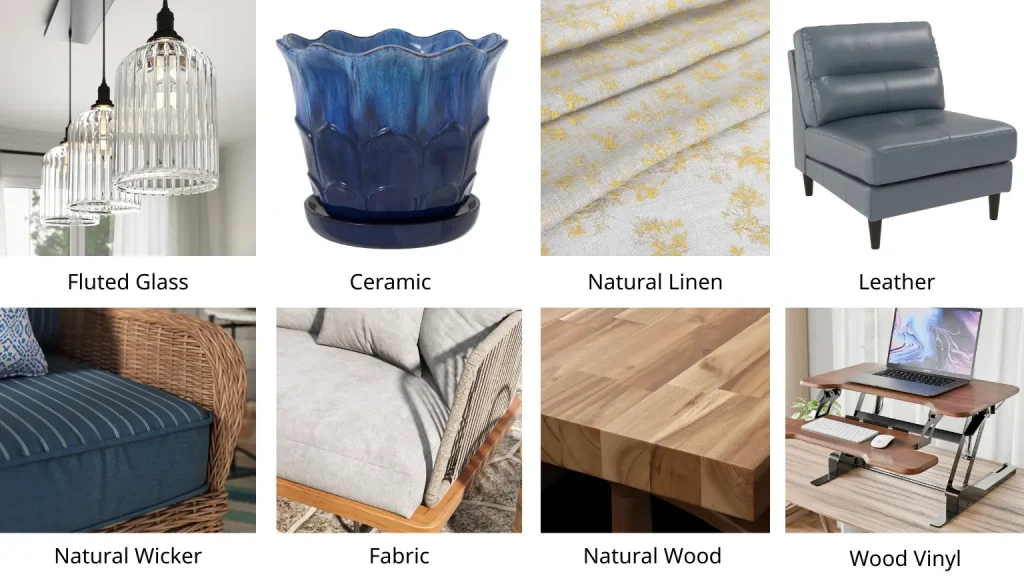
With over 30,000+ products modeled across all major industries, House of Blue Beans has built in-depth expertise in replicating real-world materials with photorealistic accuracy. Our deep experience spans across products made from:
- Metals (e.g., steel, aluminum, chrome, brass)
- Plastics & Polymers (matte, glossy, translucent, high-gloss injection molds)
- Glass & Ceramics (clear, frosted, tempered, enamel-coated)
- Natural Stone & Engineered Surfaces (granite, marble, quartz, terrazzo)
- Wood & Wood Alternatives (solid wood, veneers, MDF, plywood, laminates)
- Fabrics & Textiles (cotton, linen, velvet, leather, suede, mesh)
- Rubbers & Foams (soft-touch, neoprene, EVA, memory foam)
- Paper & Cardboard (kraft, corrugated, folded cartons)
- Composites (wicker, fiberglass, resin blends)
This extensive range of material experience enables us to faithfully recreate product surfaces, down to the grain, sheen, variation, and reflectivity, ensuring our renders are not only realistic but also allow customers to get a feel for the product.
Our material replication approach is grounded in three pillars:
- Physically-Based Shading (PBR): Every material is authored using physically accurate parameters — albedo, roughness, metallicity, specular — to ensure correct light interaction across different environments and lighting setups.
- Custom Texture Libraries & Procedural Maps: HOBB maintains a rich library of textures and shaders of industry-specific materials. For example, our wood shaders include knot variations, grain directionality, and stain tone ranges — all grounded in real product observations. This library is constantly updated and QA-tested across categories.
- Material-Specific QC: We run dedicated checks for material realism, ensuring the shader response mimics real-life behavior: Does brushed steel reflect like actual brushed metal? Does stone tile variation reflect natural randomness, not repetition? This QC process is embedded throughout our modeling, shading and rendering pipeline.
What Sets Apart HoBB’s Approach Towards Materials
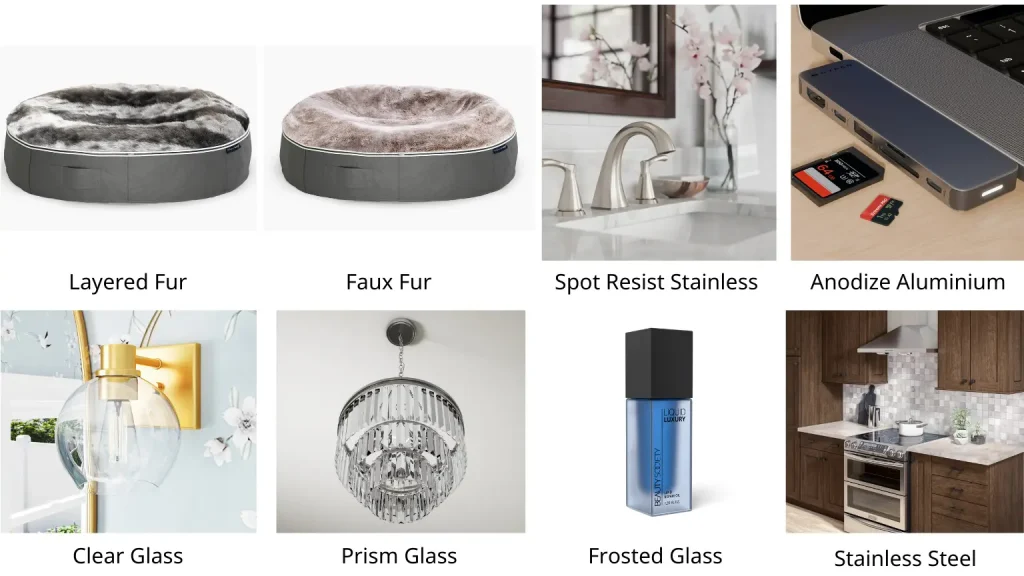
- Proprietary Multi-Industry Material Library: Developed in-house, not reliant on generic stock shaders.
- Custom Texture Authoring: Textures are created based on real products for maximum authenticity.
- Dedicated QC Process: Focused specifically on achieving true material accuracy and behavior.
- Cross-Platform Render Compatibility: Ensuring our materials look correct across various render engines.
- Artist Training: Years of specialized training for our artists in material interpretation and replication.
- Continuous Artist Training: Years of specialized training for our artists in material interpretation and replication.
Strong Command Over Technical Precision While Rendering
At HoBB, our artists have expert command over nuanced lighting and atmospheric effects, implementing accurate global illumination, soft shadow gradations, and precise HDRI control while balancing realism with render efficiency. We meticulously achieve realistic camera emulation, mimicking physical lens characteristics like depth of field. Refined and non-destructive post-production is applied if needed for impeccable color accuracy and enhancement. Furthermore, through rigorous rendering optimization and artifact mitigation, we fine-tune complex engine settings and manage resources to deliver hyper-realistic images free from noise even for complex, large-scale scenes.
Realism = Trust: The HoBB Guarantee
Customers make split-second judgments based on product visuals. If a fabric looks synthetic when it should be rich linen, or if a quartz surface appears flat and plastic-like, that crucial initial trust is instantly lost. By authentically and meticulously replicating materials, HoBB builds that essential trust in your product, even before a customer touches a single physical sample.
Here is an example of how photorealistic CGI visuals can make a world of difference with the online shopper.
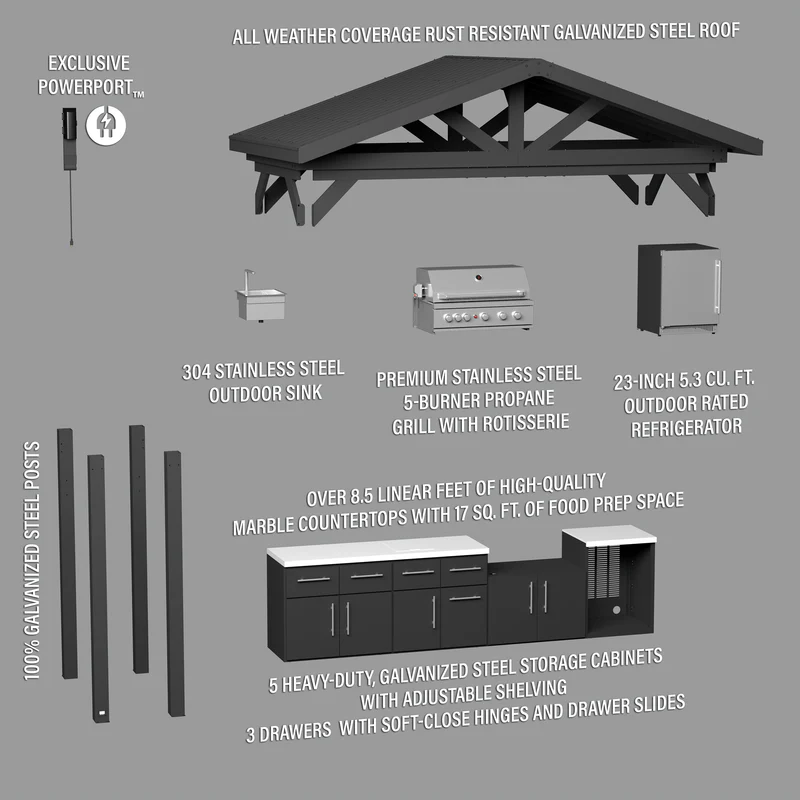
An exploded view of outdoor kitchen products
The above image was originally used to showcase the multiple features of an outdoor kitchen product. Each of these features has been blown up into photorealistic product renders in context to create trust with the online shopper.
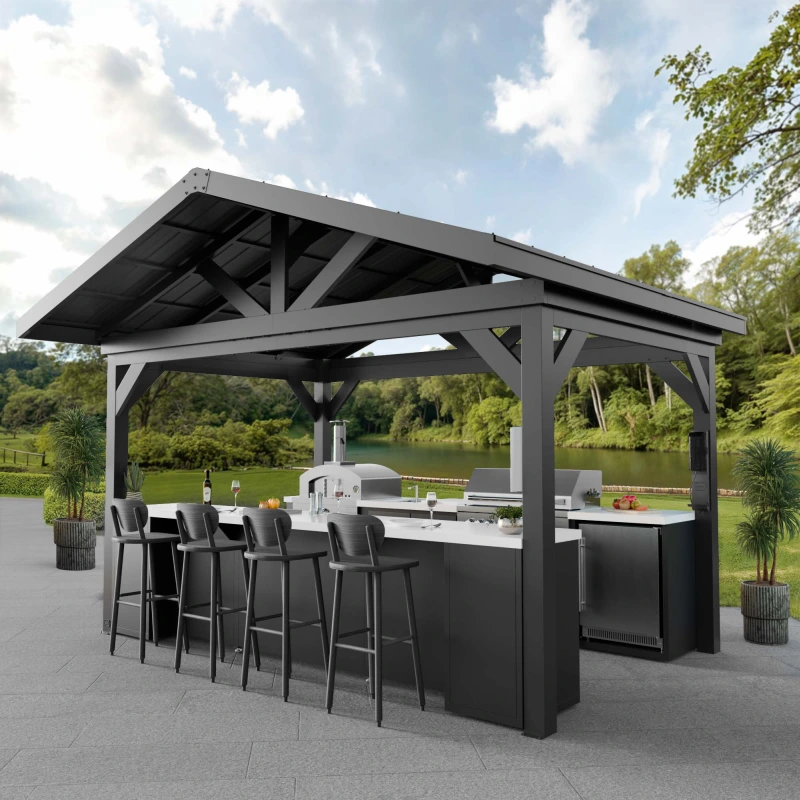
3D Rendering of an Outdoor Kitchen
A full-size shot of the outdoor kitchen in an inspirational backyard environment gives context to the buyer about the lifestyle that this product could provide. We take extra care to craft the environment with a photorealistic backdrop that also aligns with the brand guidelines and product use cases.
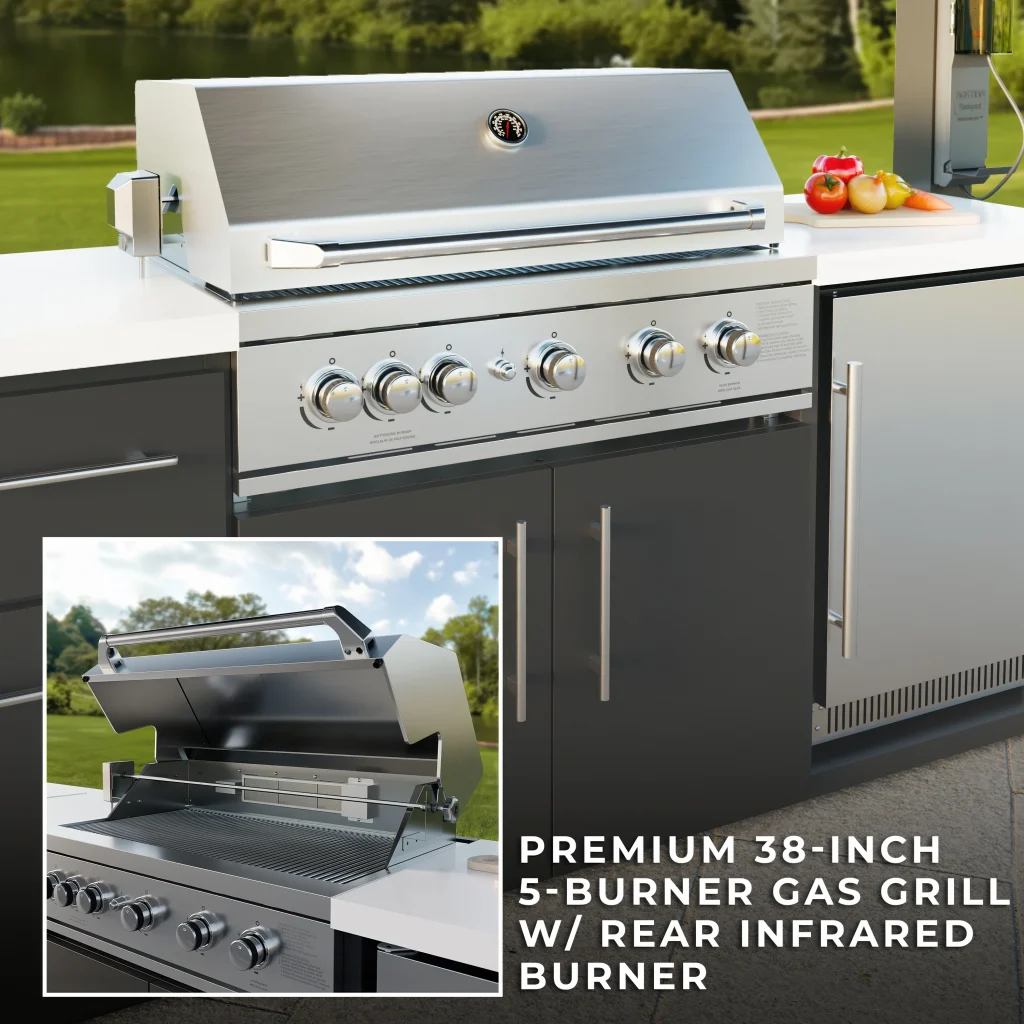
The image above shows a photorealistic render of a 5-burner Gas Grill in an outdoor setting. The metal texture accurately represents the premium quality of the material. The environmental lighting brings the sunset tone to the visual, making the viewer actually feel using the product in the setting rather than just seeing the product

When an online shopper views a product claiming to have a feature such as a pizza oven, it is hard for them to trust how big or small it could be, how functional it will be, will it even work, or is it a namesake feature, is it of good quality, what are the materials that have gone in to making it, etc,. To answer all of these questions, we create a photorealistic product render that not just represents the product accurately, but also shows the feature in action. The trust that is built with the online shopper when they are able to see the product in action, in a contextual environment and in both open and closed states is of another level. Trust is built through the visual, thereby increasing purchase consideration and possibly conversion.
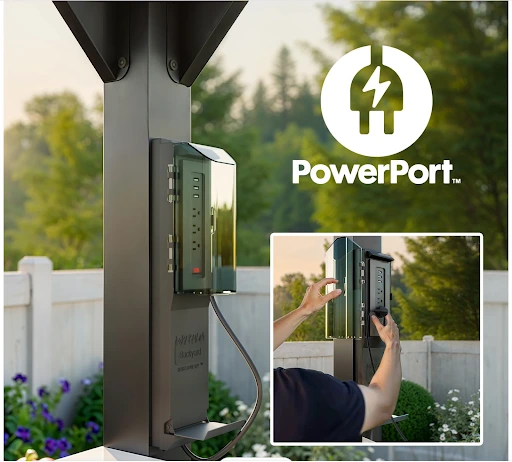
In the above render of a power port, the shallow depth of field, creating a soft bokeh from the background foliage, perfectly simulates a camera lens. This highlights the product well. The transparent cover exhibits accurate refraction of the outlets and subtle, realistic environmental reflections. Soft, diffuse lighting on the matte black post and the unit ensures seamless integration into the outdoor scene. Also, showing a person actively using the PowerPort demonstrates the product’s intuitive usability and ergonomic scale. The viewer not just sees the product, but is able to experience using it.
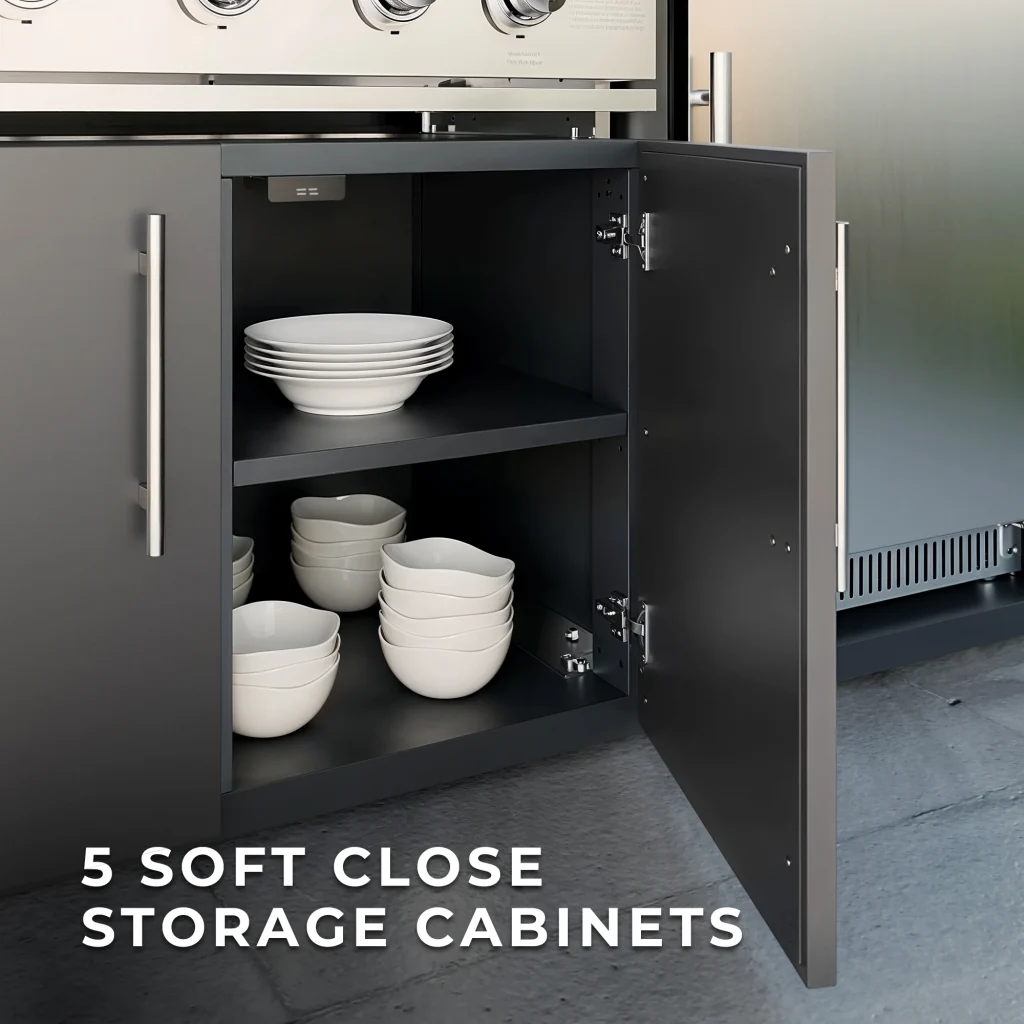
The 3D rendering of the storage cabinet shows the proper size perspective as to how much space is available inside. The stacked bowls show the natural usage of the cabinet, making the visuals look realistic and not artificial. The clear finishing on the edges and the hinge convey the soft-close feature.
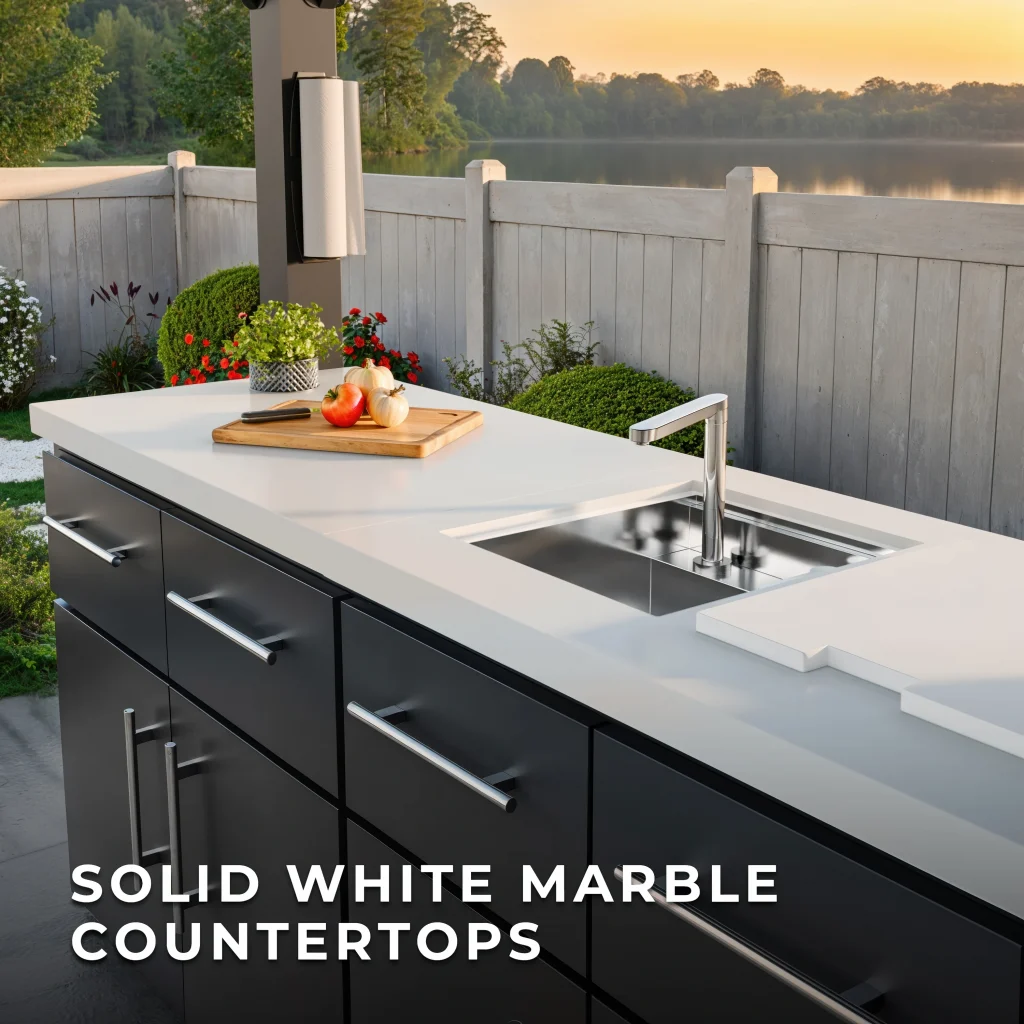
The above rendering successfully builds trust by ensuring the entire environment, not just the product, is a convincing real-world replica. The lighting mimics the sun that casts soft, directionally consistent shadows and bathes the scene in a warm, low-angle glow, avoiding an artificial studio look. The material simulation is well detailed. The solid white marble countertop features a realistic honed finish; its matte surface diffuses the warm sunlight naturally. On the fixtures, the brushed steel of the faucet and cabinet pulls is rendered with precision, accurately showing how the texture and curvature create soft, distorted reflections rather than the unnaturally perfect gleam of simpler CG metal. The background foliage displays crucial variation in leaf form and orientation, while meticulously modeled props, like the vibrant tomato and onion on the cutting board and the potted plant, provide high-fidelity detail that makes the scene feel tangible and authentic. This level of photorealism ensures the viewer gets the feel of actually standing in front of the product and using it in an attractive environment.
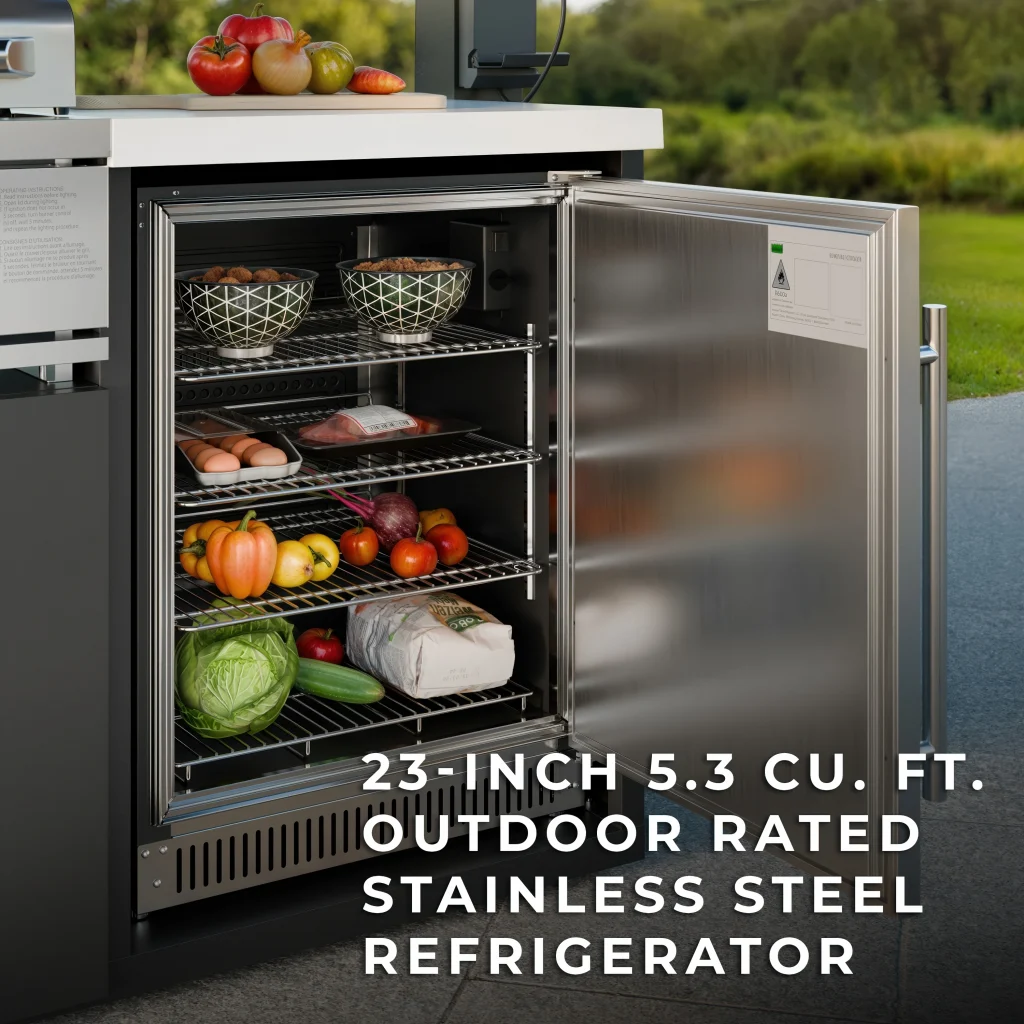
The above render of the fridge balances the soft, diffuse ambient light from the outdoor environment with the cooler, more direct illumination from the refrigerator’s internal LED source. This duality creates depth, realistic light falloff on the lower shelves, and accurate, soft shadows that give each item believable volume. The brushed stainless steel interior and door frame correctly diffuse reflections, avoiding the artificial, mirror-like quality of less advanced renders. The vegetables, like the gourds and peppers, showcase a masterful use of subsurface scattering, which simulates how light penetrates the waxy skin to create a believable translucence. This is complemented by high-resolution textures on the wrinkled paper bag, the subtle sheen on the plastic-wrapped meat, and the delicate texturing on the eggshells. Photorealism is about having an eye for detail. The inclusion of the yellow warning sticker on the door, the slight, natural irregularity in the placement of items, and the realistic wire texture of the shelves all serve to disrupt digital perfection and create a truly trustworthy visual experience.
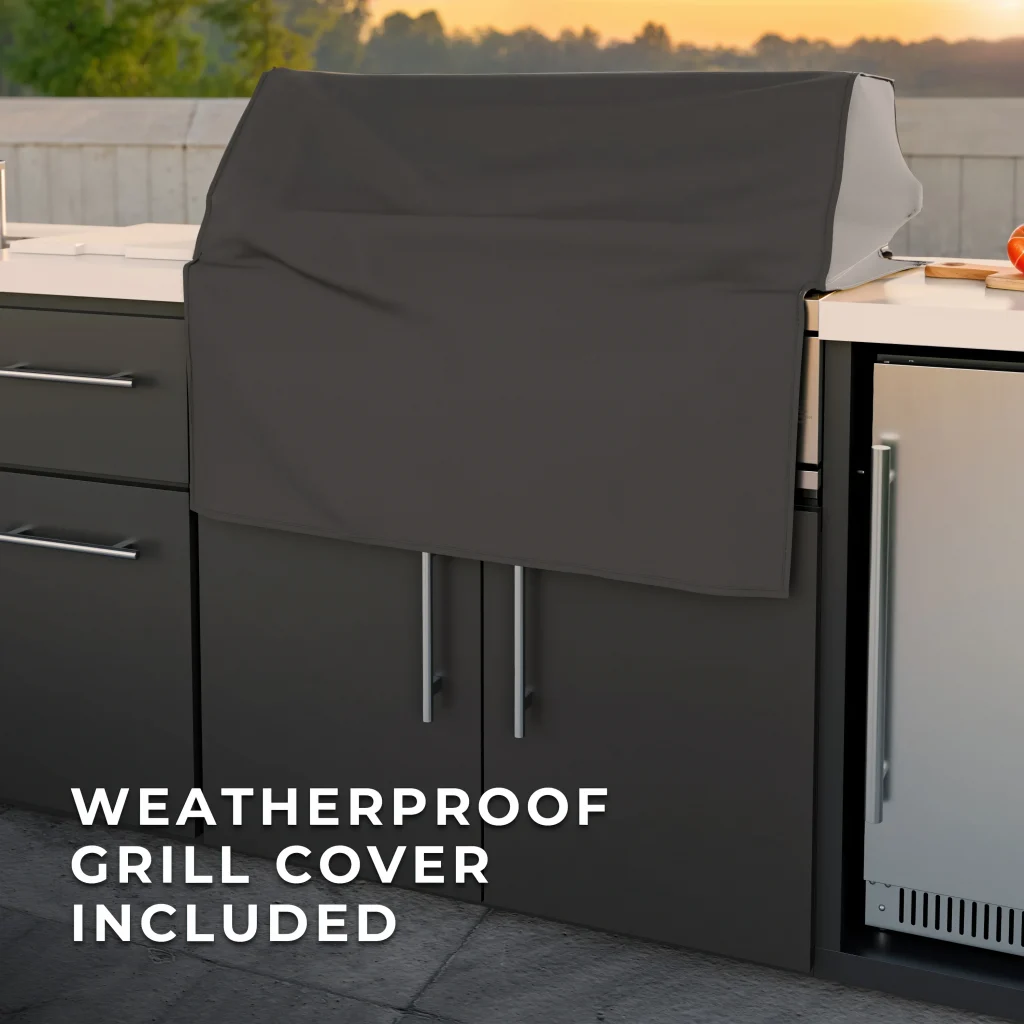
The above render shows a weatherproof grill cover. We take into account even little imperfections. The folds visible on the cover are an example of that. They make the cover look very realistic and give the customer the actual feel of looking at the product and how it fits the grill.
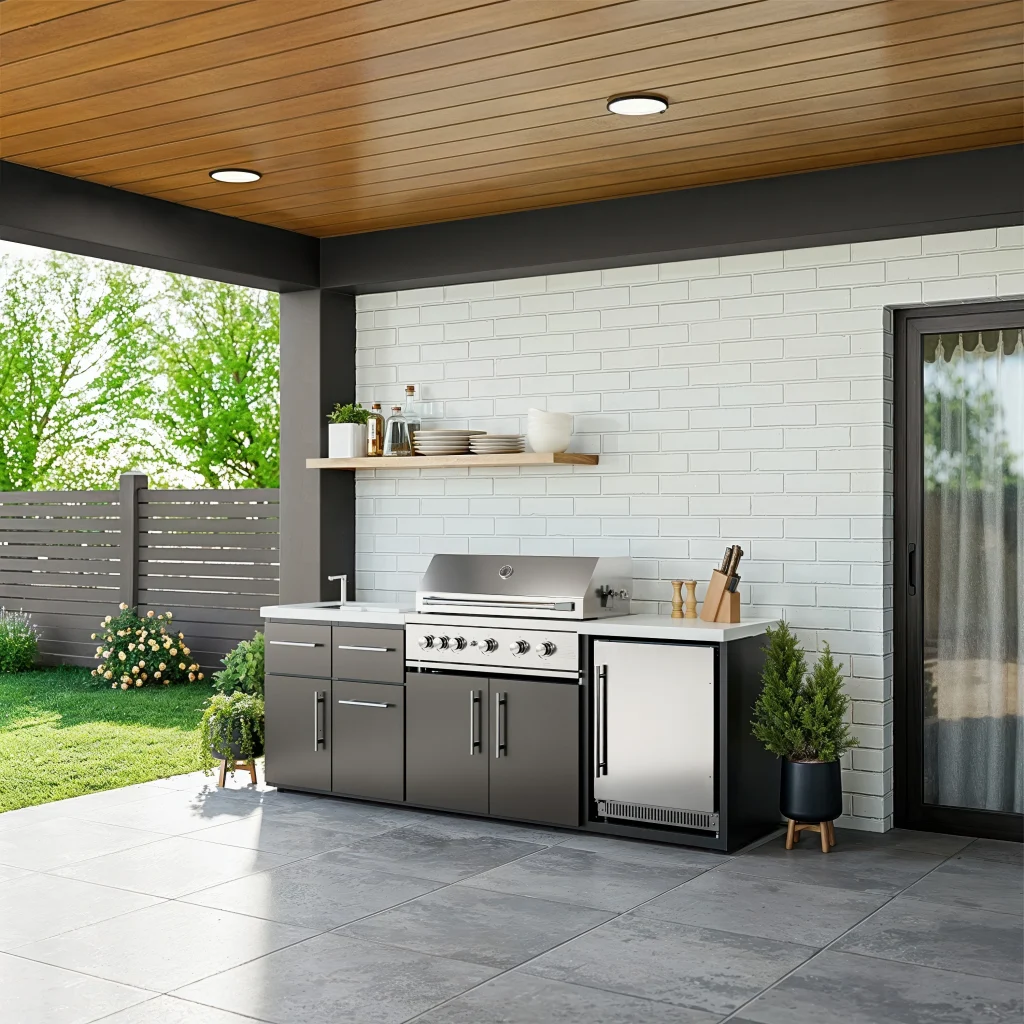
3D rendering of an outdoor kitchen setup
Ensuring that the product is accurately represented and photorealistic is only one aspect of gaining the customer’s trust. But this trust can be misplaced quickly if other aspects of the environment are not realistic and real-world-like. The most challenging aspect of creating photorealistic renders is to be able to create real world replicas of detailed environments. Plants – shape, form and texture of each leaf need to be unique for it to mimic the real world. Flooring – when floor tiles are laid out, it is important to note that the texture orientation on each tile needs to be different to create subtle variation to mimic reality. As in real life, it is impossible for all floor tiles to be laid out in the exact same orientation. Glass – thickness, reflection on the glass, etc, are important aspects to show the quality of the environment. Lighting in the scene needs to be natural and not studio-like. The shadows of the plants need to be subtle, yet distinct, to represent the shape of the actual object. Grass – As part of the environment creation process, we brush the grass/lawn to create variations in height across the garden and also certain small gaps between them to mimic a real world, lived in.

It is important to note that this image looks photorealistic because of the realism in the plastic bag inserted into the garbage bin. The imperfections on the top edge of the plastic bin mimic the tucking in and insertion of the bag into the bin. The stretch marks on the bag show that there is something inside the bin that is pulling the bag down, replicating the real-world look of how a plastic bag would look when it is in use. These subtle imperfections impact the cognitive processing of an online customer at a subconscious level and allow a customer to process the product to be a real and believable product.
We actively avoid common CGI pitfalls that plague many vendors, such as unnaturally shiny wicker, leather that resembles plastic, or wood textures that look tiled or artificial. At HoBB, we ensure the organic imperfections, subtle variations, and tactile cues necessary to make every material thoroughly believable and trustworthy. We are committed to delivering the highest quality visualization services. To ensure satisfaction and confidence in our offerings, we have also created a Zero-Cost Defect Rectification Policy.
